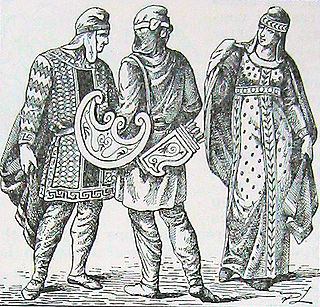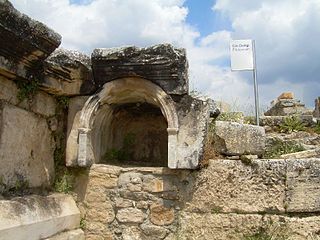Related Research Articles

Mystery religions, mystery cults, sacred mysteries or simply mysteries, were religious schools of the Greco-Roman world for which participation was reserved to initiates (mystai). The main characterization of this religion is the secrecy associated with the particulars of the initiation and the ritual practice, which may not be revealed to outsiders. The most famous mysteries of Greco-Roman antiquity were the Eleusinian Mysteries, which predated the Greek Dark Ages. The mystery schools flourished in Late Antiquity; Emperor Julian, of the mid 4th century, is believed by some scholars to have been associated with various mystery cults—most notably the mithraists. Due to the secret nature of the school, and because the mystery religions of Late Antiquity were persecuted by the Christian Roman Empire from the 4th century, the details of these religious practices are derived from descriptions, imagery and cross-cultural studies. Much information on the Mysteries comes from Marcus Terentius Varro.

Cybele is an Anatolian mother goddess; she may have a possible forerunner in the earliest neolithic at Çatalhöyük. She is Phrygia's only known goddess, and was probably its national deity. Greek colonists in Asia Minor adopted and adapted her Phrygian cult and spread it to mainland Greece and to the more distant western Greek colonies around the 6th century BC.

Agdistis is a deity of Greek, Roman, and Anatolian mythology who was a Hermaphrodite, having been born with both male and female reproductive organs. The deity was closely associated with the Phrygian goddess Cybele.

In ancient Roman religion and mythology, Liber, also known as Liber Pater, was a god of viticulture and wine, male fertility and freedom. He was a patron deity of Rome's plebeians and was part of their Aventine Triad. His festival of Liberalia became associated with free speech and the rights attached to coming of age. His cult and functions were increasingly associated with Romanised forms of the Greek Dionysus/Bacchus, whose mythology he came to share.

A gallus was a eunuch priest of the Phrygian goddess Cybele and her consort Attis, whose worship was incorporated into the state religious practices of ancient Rome.

Festivals in ancient Rome were a very important part in Roman religious life during both the Republican and Imperial eras, and one of the primary features of the Roman calendar. Feriae were either public (publicae) or private (privatae). State holidays were celebrated by the Roman people and received public funding. Games (ludi), such as the Ludi Apollinares, were not technically feriae, but the days on which they were celebrated were dies festi, holidays in the modern sense of days off work. Although feriae were paid for by the state, ludi were often funded by wealthy individuals. Feriae privatae were holidays celebrated in honor of private individuals or by families. This article deals only with public holidays, including rites celebrated by the state priests of Rome at temples, as well as celebrations by neighborhoods, families, and friends held simultaneously throughout Rome.

Attis was the consort of Cybele, in Phrygian and Greek mythology.

The Phrygians were an ancient Indo-European speaking people who inhabited central-western Anatolia in antiquity.
Catullus 63 is a Latin poem of 93 lines in galliambic metre by the Roman poet Catullus.
In ancient Greek religion, Kanathos in the Argolid was the spring at Nauplia, where Hera annually renewed her virginity. There, Pausanias noted, was "a spring called Kanathos where, so say the Argives, Hera bathes every year and, by so doing, becomes a maiden; it is this story which is of the secrets connected with the rites which they perform to Hera." The unspoken nature of the ritual forbade its being embodied openly or directly in Greek mythology. S. Casson suggested that it was the obscure subject of the so-called "Ludovisi Throne", generally considered to represent the parallel, and far better-known, renewal of Aphrodite, bathing in the sea at Paphos.

The Santoni are a collection of statues carved into a rock face near Palazzolo Acreide, the ancient Akrai, in Sicily.
The Megalesia, Megalensia, or Megalenses Ludi was a festival celebrated in Ancient Rome from April 4 to April 10, in honour of Cybele, known to Romans as Magna Mater. The name of the festival derives from Greek Megale (μϵγάλη), meaning "Great". Ludi were the games or entertainments associated with religious festivals.

In ancient Greek religion, an orgion was an ecstatic form of worship characteristic of some mystery cults. The orgion is in particular a cult ceremony of Dionysos, celebrated widely in Arcadia, featuring "unrestrained" masked dances by torchlight and animal sacrifice by means of random slashing that evoked the god's own rending and suffering at the hands of the Titans. The orgia that explained the role of the Titans in Dionysos's dismemberment were said to have been composed by Onomacritus. Greek art and literature, as well as some patristic texts, indicate that the orgia involved snake handling.

In classical antiquity, Phrygia was a kingdom in the west-central part of Anatolia, in what is now Asian Turkey, centered on the Sangarios River. After its conquest, it became a region of the great empires of the time.

Ma was a local goddess at Comana in Cappadocia. Her name Ma means "Mother", and she also had the epithets "Invincible" and "Bringer of Victory".

A ploutonion is a sanctuary specially dedicated to the ancient Greek god Plouton. Only a few such shrines are known from classical sources, usually at locations that produce poisonous emissions and were considered to represent an entrance to the underworld.

Femminielli or femmenielli are a population of people who embody a third gender role in traditional Neapolitan culture. It may be hard to define this term within modern Western notions of "gay men" versus "trans women" since both these categories overlap to a degree in the case of femminielli. This term is not derogatory and does not carry a stigma; instead femminielli are traditionally believed to bring good luck.

Hiereiai was the title of the female priesthood or priestesses in ancient Greek religion, being the equivalent of the male title Hierei. Ancient Greece had a number of different offices in charge of worship of gods and goddesses, and both women and men functioned as priests. While there were local variations depending on cult, the Hiereiai had many similarities across ancient Greece. Normally, their office related only to a specific sanctuary or Greek temple.
Sacerdos Cereris, sacerdos Cerealis or sacerdos Cereris publica was the title of the Priestess of the goddess Ceres in Ancient Rome. It was one of two Roman state cults to include female priests.
Priestess of Hathor or Prophetess of Hathor was the title of the Priestess of the goddess Hathor in the Temple of Dendera in Ancient Egypt.
References
- ↑ Meghan J. DiLuzio: A Place at the Altar: Priestesses in Republican Rome
- Scheid, John, An introduction to Roman religion, Edinburgh University Press, Edinburgh, 2002